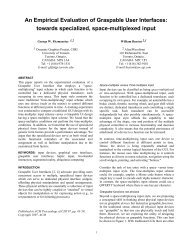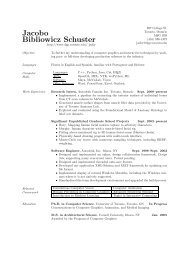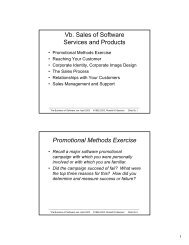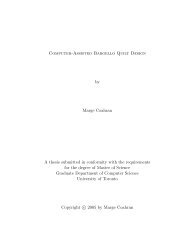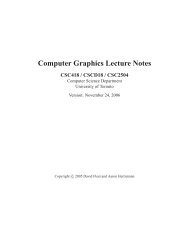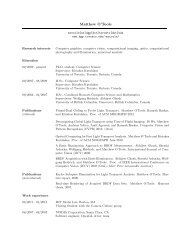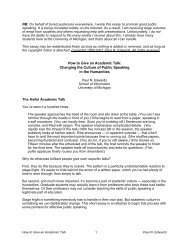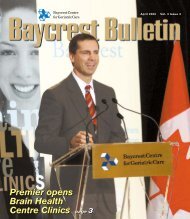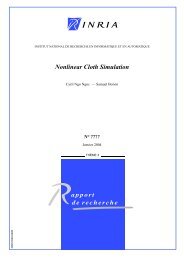The Fundamental Principles of Animation
The Fundamental Principles of Animation
The Fundamental Principles of Animation
Create successful ePaper yourself
Turn your PDF publications into a flip-book with our unique Google optimized e-Paper software.
Tutorial #11<br />
Prepared by Gustavo Carneiro<br />
This tutorial was based on the Notes by P. Coleman,<br />
on the web-page http://www.comet-cartoons.com/toons/3ddocs/charanim/,<br />
and on the paper “<strong>Principles</strong> <strong>of</strong> Traditional <strong>Animation</strong> Applied to 3D Computer<br />
<strong>Animation</strong>”. By J. Lasseter, Pixar, San Rafael, California. In ACM Computer Graphics<br />
(21), 4, July 1987.<br />
<strong>The</strong> <strong>Fundamental</strong> <strong>Principles</strong> <strong>of</strong> <strong>Animation</strong><br />
It all started after the 30s when Walt Disney noticed that the level <strong>of</strong> animation was<br />
inadequate for some new story lines. Classes for his animators were set up under the<br />
instruction <strong>of</strong> Don Graham. Before those classes, the animations were made with little or<br />
no reference to nature. Out <strong>of</strong> these classes grew a new way <strong>of</strong> drawing moving human<br />
figures and animals, where the analysis <strong>of</strong> real action became important to the development<br />
<strong>of</strong> animation. After a while, each technique was named and they became known as the<br />
fundamental principles <strong>of</strong> animation.<br />
Ultimately, the animator must have a sense <strong>of</strong> what makes an inanimate character alive.<br />
<strong>The</strong> principles are:<br />
1. Timing<br />
2. Ease In and Out (or Slow In and Out)<br />
3. Arcs<br />
4. Anticipation<br />
5. Exaggeration<br />
6. Squash and Stretch<br />
7. Secondary Action<br />
8. Follow Through and Overlapping Action<br />
9. Straight Ahead Action and Pose-To-Pose Action<br />
10. Staging<br />
11. Appeal<br />
12. Personality<br />
Simply memorizing these principles isn’t the point. No one will care whether or not you<br />
know this list. It’s whether or not you truly understand and can utilize these ideas that<br />
matter. If you do, it will show automatically in your work.<br />
1. Timing<br />
Timing is the essence <strong>of</strong> animation. <strong>The</strong> speed at which something moves gives a sense <strong>of</strong><br />
what the object is, the weight <strong>of</strong> an object, and why it is moving. Something like an eye<br />
blink can be fast or slow. If it’s fast, a character will seem alert and awake. If it’s slow the<br />
character may seem tired and lethargic.<br />
J. Lesseter’s example. Head that turns left and right.
• Head turns back and forth really slow: it may seem as if the character is stretching his<br />
neck (lots <strong>of</strong> in between frames).<br />
• A bit faster it can be seen as saying "no" (a few in between frames)<br />
• Really fast, and the character is reacting to getting hit by a baseball bat (almost none in<br />
between frames).<br />
2. Ease In and Out (or Slow In and Out)<br />
Ease in and out has to do with gradually causing an object to accelerate, or come to rest,<br />
from a pose. An object or limb may slow down as it approaches a pose (Ease In) or<br />
gradually start to move from rest (Ease Out).<br />
For example, a bouncing ball tends to have a lot <strong>of</strong> ease in and out when at the top <strong>of</strong> its<br />
bounce. As it goes up, gravity affects it and slows down (Ease In), then it starts its<br />
downward motion more and more rapidly (Ease Out), until it hits the ground.<br />
Note that this doesn’t mean slow movement. This really means keep the in between frames<br />
close to each extreme.<br />
3. Arcs<br />
In the real world almost all action moves in an arc. When creating animation one should try<br />
to have motion follow curved paths rather than linear ones. It is very seldom that a<br />
character or part <strong>of</strong> a character moves in a straight line. Even gross body movements when<br />
you walk somewhere tend not be perfectly straight. When a hand/arm reaches out to reach<br />
something, it tends to move in an arc.<br />
Simple example – Kicking a ball<br />
Trajectory <strong>of</strong> the ball
4. Anticipation<br />
Action in animation usually occurs in three sections. <strong>The</strong> setup for the motion, the actual<br />
action and then follow-through <strong>of</strong> the action. <strong>The</strong> first part is known as anticipation.<br />
In some cases anticipation is needed physically. For example, before you can throw a ball<br />
you must first swing your arm backwards. <strong>The</strong> backwards motion is the anticipation, the<br />
throw itself is the motion.<br />
Anticipation is used to lead the viewers eye to prepare them for the action that follows.<br />
Longer period <strong>of</strong> anticipation is needed for faster actions. Example, a character zips <strong>of</strong>f<br />
screen leaving a puff <strong>of</strong> smoke. Usually just before the zip, there is a pose where the<br />
characters raises a leg and bends both arms as if he’s about to run. That’s the anticipation<br />
pose for the <strong>of</strong>f screen run.<br />
Generally, for good clear animation, the viewer should know what is about happen<br />
(anticipation), what is happening (the actual action itself) and what happened (related to<br />
follow through).<br />
5. Exaggeration<br />
Exaggeration is used to accent an action. It should be used in a careful and balanced<br />
manner, not arbitrarily. Figure out what the desired goal <strong>of</strong> an action or sequence is and<br />
what sections need to be exaggerated. <strong>The</strong> result will be that the animation will seem more<br />
realistic and entertaining.<br />
One can exaggerate motions, for example an arm may move just a bit too far briefly in an<br />
extreme swing. Generally when animating to dialogue, one listens to the track and picks out<br />
areas that sound like they have more stress or importance, and then tends to exaggerate<br />
poses and motions that fall at those times.<br />
<strong>The</strong> key is to take something and make it more extreme in order to give it more life, but not<br />
so much that it destroys believability. Example: exaggerating the lamp proportions to give<br />
a sense <strong>of</strong> dad and son.
6. Squash and Stretch<br />
Squash and stretch is a way <strong>of</strong> deforming an object such that it shows how rigid the object<br />
is. For example if a rubber ball bounces and hits the ground it will tend to flatten when it<br />
hits. This is the squash principle. As it starts to bounce up it will stretch in the direction it is<br />
going. Squash and Stretch was also initially done to prevent strobing due to lack <strong>of</strong> motion<br />
blur.<br />
An important note about squash and stretch, is that no matter how an object deforms, it<br />
should still appear to retain its volume. <strong>The</strong> most obvious usage in character animation is<br />
muscles. When a muscle is contracted it will squash and when extended, it stretches.<br />
Rigid objects can still squash and stretch in a way. Think <strong>of</strong> the lamps above. <strong>The</strong> lamp<br />
itself is a rigid metal object. But before it jumps it anticipates the action by crouching down<br />
and bending. That bending is basically squash and stretch.<br />
7. Secondary Action<br />
Secondary action creates interest and realism in animation. It should be staged such that it<br />
can be noticed but still not overpower the main action. A good example <strong>of</strong> this is a<br />
character at a table acting and delivering their main acting. A side piece <strong>of</strong> acting business<br />
might be the character thumbing their fingers on the table. This isn’t the main action say,<br />
perhaps it occurs as the other hand is more largely gesturing and your focus is on the face.
But it is something that the character is doing/acting that adds a more realistic and natural<br />
feel to the animation. As mentioned, it must be staged so that the main action isn’t<br />
overpowered. It’s the kind <strong>of</strong> thing that is usually more subtle or can be felt more than<br />
noticed immediately.<br />
8. Follow Through and Overlapping Action<br />
Follow Through is the same as anticipation, only at the end <strong>of</strong> an action. It is usually<br />
animated as something goes past its resting point and then coming back to where it would<br />
normally be. For example, in throwing a ball, you put your hand back, that’s anticipation,<br />
it’s the preparation for the throwing action itself. <strong>The</strong>n you throw the arm comes forward<br />
for the main action. Follow Through is then the arm continuing past the normal stopping<br />
point, overshooting it and then coming back. <strong>The</strong> arm has continued or "followed through"<br />
on the action it was doing before returning back to rest.<br />
Overlapping Action is an action that occurs because <strong>of</strong> another action. For example if a dog<br />
is running and suddenly comes to a stop, its ears will probably still keep moving for a bit.<br />
Another example, if an alien is walking and it has an antenna on it, the antenna will<br />
probably sway as a result <strong>of</strong> the main body motion. This is overlapping action. It is caused<br />
because <strong>of</strong> the main motion and overlaps on top <strong>of</strong> the main motion.<br />
9. Straight Ahead Action and Pose-To-Pose Action<br />
<strong>The</strong>re are 2 basic methods to creating animation. Straight ahead animation is one where the<br />
animator draws or sets up objects one frame at a time in order. For example, the animator<br />
draws the first frame <strong>of</strong> the animation, then draws the second, and so on until the sequence<br />
is complete. In this way, there is one drawing or image per frame that the animator has<br />
setup. This approach tends to yield a more creative and fresh look but can be difficult to<br />
time correctly and tweak.<br />
<strong>The</strong> other approach is Pose-To-Pose animation. Pose to Pose is created by drawing or<br />
setting up key poses and then drawing or creating inbetween images. This is the basic<br />
computer "keyframe" approach to animation. It is excellent for tweaking timing and<br />
planning out the animation ahead <strong>of</strong> time. You figure out the key poses, and then the<br />
motion inbetween is generated from that. This is very useful when specific timing or action<br />
must occur at specific points. You always know exactly what will happen.<br />
<strong>The</strong> basic difference is with Pose-To-Pose you plan out, and know exactly what will<br />
happen ahead <strong>of</strong> time, whereas with Straight Ahead, you’re not quite sure how things will<br />
turn out until you are done. With computers, some people tend to create a hybrid <strong>of</strong> the two,<br />
planning out the overall poses, and then straight ahead animating the stuff inbetween.<br />
10. Staging<br />
Staging is presenting an action or item so that it is easily understood. An action is staged so<br />
that it is understood; a personality is staged so that it is recognizable; an expression so that<br />
it can be seen; a mood so that it will affect the audience.<br />
In general, it is important that action is presented one item at a time. If too much is going<br />
on the audience will be unsure what to look at and the action will be "upstaged".
With characters, it is important to really think about whether or not each pose for an action<br />
adequately and correctly reads to the audience. You should also make sure no two parts <strong>of</strong> a<br />
character contradict each other (unless it’s intended). For example if you’re staging a sad<br />
pose you may have the character hunched over with his arms hanging at his sides and a<br />
high camera angle...but if you give him this big grin on his face it won’t fit with the rest <strong>of</strong><br />
the pose.<br />
Staging multiple characters is also an important issue. Generally you want to always make<br />
sure you know where the audience is looking within the shot. Background characters must<br />
be animated such that they are still "alive", but not so much that they steal the viewer’s<br />
attention from the main action. Staging like this is also related to a lot <strong>of</strong> directing and<br />
editing principles.<br />
11. Appeal<br />
Appeal means anything that a person likes to see. This can be quality <strong>of</strong> charm, design,<br />
simplicity, communication or magnetism. Appeal can be gained by correctly utilizing other<br />
principles such as exaggeration in design, avoiding symmetry, using overlapping action,<br />
and others. One should strive to avoid weak or awkward design, shapes and motion.<br />
It's important to note that appeal doesn't necessarily mean good vs. evil. For example, in<br />
Disney's animated classic "Peter Pan", Captain Hook is an evil character, but most people<br />
would agree that his character and design has appeal. <strong>The</strong> same goes for Hopper in "A<br />
Bug's Life". Even though he's mean and nasty, his design and characterization/personality<br />
still has a lot <strong>of</strong> appeal.<br />
12. Personality<br />
This word isn't actually a true principle <strong>of</strong> animation, but refers to the correct application <strong>of</strong><br />
the other principles. Personality determines the success <strong>of</strong> an animation. <strong>The</strong> idea is that the<br />
animated creature really becomes alive and enters the true character <strong>of</strong> the role. One<br />
character would not perform an action the same way in two different emotional states. No<br />
two characters would act the same. It is also important to make the personality <strong>of</strong> a<br />
character distinct, but at the same time be familiar to the audience.<br />
Personality has a lot to do with what is going on in the mind <strong>of</strong> the character, as well as the<br />
traits and mannerisms <strong>of</strong> the character. It is helpful to have some background in acting, and<br />
certainly taking an acting or improve class as an animator is a good idea.<br />
What Character <strong>Animation</strong> Isn’t<br />
Character animation is about an artist bringing a character to life. It isn't rotoscoping or<br />
blindly copying motion. It isn't using raw motion capture or other automated techniques to<br />
make something simply move. In much the same way tracing isn't really drawing,<br />
animation requires the artist to interpret and create something that is more than the original.<br />
<strong>The</strong> above principles are the foundation upon which good character animation lies. With<br />
practice, patience and perseverance ones animation skills will improve.



